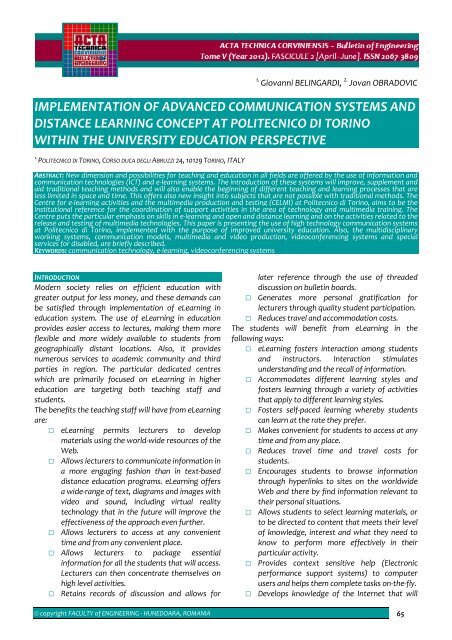Editorial & Advisory Board - Acta Technica Corviniensis
Editorial & Advisory Board - Acta Technica Corviniensis
Editorial & Advisory Board - Acta Technica Corviniensis
Create successful ePaper yourself
Turn your PDF publications into a flip-book with our unique Google optimized e-Paper software.
1.<br />
Giovanni BELINGARDI, 2. Jovan OBRADOVIC<br />
IMPLEMENTATION OF ADVANCED COMMUNICATION SYSTEMS AND<br />
DISTANCE LEARNING CONCEPT AT POLITECNICO DI TORINO<br />
WITHIN THE UNIVERSITY EDUCATION PERSPECTIVE<br />
1.<br />
POLITECNICO DI TORINO, CORSO DUCA DEGLI ABRUZZI 24, 10129 TORINO, ITALY<br />
ABSTRACT: New dimension and possibilities for teaching and education in all fields are offered by the use of information and<br />
communication technologies (ICT) and e‐learning systems. The introduction of these systems will improve, supplement and<br />
aid traditional teaching methods and will also enable the beginning of different teaching and learning processes that are<br />
less limited in space and time. This offers also new insight into subjects that are not possible with traditional methods. The<br />
Centre for e‐learning activities and the multimedia production and testing (CELMI) at Politecnico di Torino, aims to be the<br />
institutional reference for the coordination of support activities in the area of technology and multimedia training. The<br />
Centre puts the particular emphasis on skills in e‐learning and open and distance learning and on the activities related to the<br />
release and testing of multimedia technologies. This paper is presenting the use of high technology communication systems<br />
at Politecnico di Torino, implemented with the purpose of improved university education. Also, the multidisciplinary<br />
working systems, communication models, multimedia and video production, videoconferencing systems and special<br />
services for disabled, are briefly described.<br />
KEYWORDS: communication technology, e‐learning, videoconferencing systems<br />
INTRODUCTION<br />
Modern society relies on efficient education with<br />
greater output for less money, and these demands can<br />
be satisfied through implementation of eLearning in<br />
education system. The use of eLearning in education<br />
provides easier access to lectures, making them more<br />
flexible and more widely available to students from<br />
geographically distant locations. Also, it provides<br />
numerous services to academic community and third<br />
parties in region. The particular dedicated centres<br />
which are primarily focused on eLearning in higher<br />
education are targeting both teaching staff and<br />
students.<br />
The benefits the teaching staff will have from eLearning<br />
are:<br />
eLearning permits lecturers to develop<br />
materials using the world‐wide resources of the<br />
Web.<br />
Allows lecturers to communicate information in<br />
a more engaging fashion than in text‐based<br />
distance education programs. eLearning offers<br />
a wide‐range of text, diagrams and images with<br />
video and sound, including virtual reality<br />
technology that in the future will improve the<br />
<br />
effectiveness of the approach even further.<br />
Allows lecturers to access at any convenient<br />
time and from any convenient place.<br />
Allows lecturers to package essential<br />
information for all the students that will access.<br />
Lecturers can then concentrate themselves on<br />
high level activities.<br />
<br />
Retains records of discussion and allows for<br />
later reference through the use of threaded<br />
discussion on bulletin boards.<br />
Generates more personal gratification for<br />
lecturers through quality student participation.<br />
Reduces travel and accommodation costs.<br />
The students will benefit from eLearning in the<br />
following ways:<br />
<br />
<br />
<br />
<br />
<br />
<br />
<br />
<br />
<br />
eLearning fosters interaction among students<br />
and instructors. Interaction stimulates<br />
understanding and the recall of information.<br />
Accommodates different learning styles and<br />
fosters learning through a variety of activities<br />
that apply to different learning styles.<br />
Fosters self‐paced learning whereby students<br />
can learn at the rate they prefer.<br />
Makes convenient for students to access at any<br />
time and from any place.<br />
Reduces travel time and travel costs for<br />
students.<br />
Encourages students to browse information<br />
through hyperlinks to sites on the worldwide<br />
Web and there by find information relevant to<br />
their personal situations.<br />
Allows students to select learning materials, or<br />
to be directed to content that meets their level<br />
of knowledge, interest and what they need to<br />
know to perform more effectively in their<br />
particular activity.<br />
Provides context sensitive help (Electronic<br />
performance support systems) to computer<br />
users and helps them complete tasks on‐the‐fly.<br />
Develops knowledge of the Internet that will<br />
© copyright FACULTY of ENGINEERING ‐ HUNEDOARA, ROMANIA 65

















